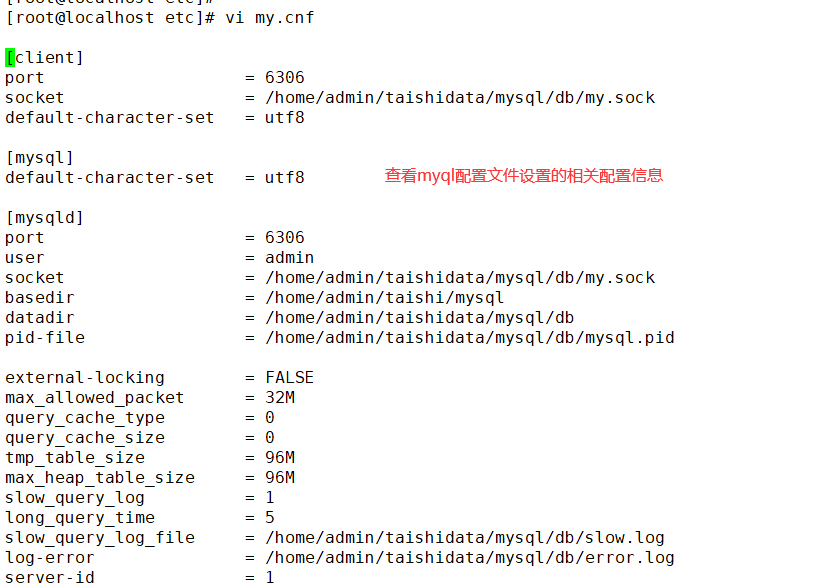环境变量设置
设置root用户的密码

端口映射

处理用户远程连接登录异常
create user 'taishi'@'%' identified by 'aransfar@123';
grant all privileges on *.* to 'taishi'@'%' with grant option;
flush privileges;
ALTER USER 'taishi'@'%' IDENTIFIED WITH mysql_native_password BY 'aransfar@123';
set global log_bin_trust_function_creators=1;
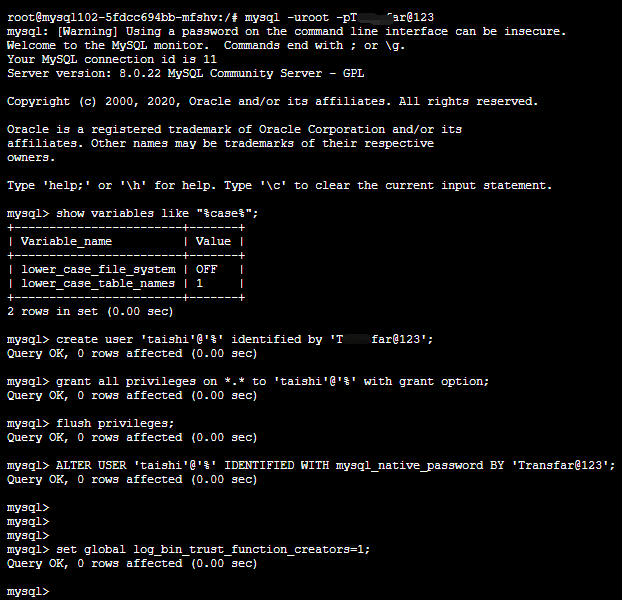
处理mysql8在sql查询语句中不区分大小写字符



docker run --name mysql -p 33306:3306 -v /home/admin/mysql:/var/lib/mysql -e MYSQL_ROOT_PASSWORD="Transfar@123" ab2f358b8612 --lower-case-table-names=1
--lower-case-table-names=1 相当于作为entrypoint.sh的命令参数 参数的前面需要加--

所有服务正常连接数据库并启动
数据库传输同步
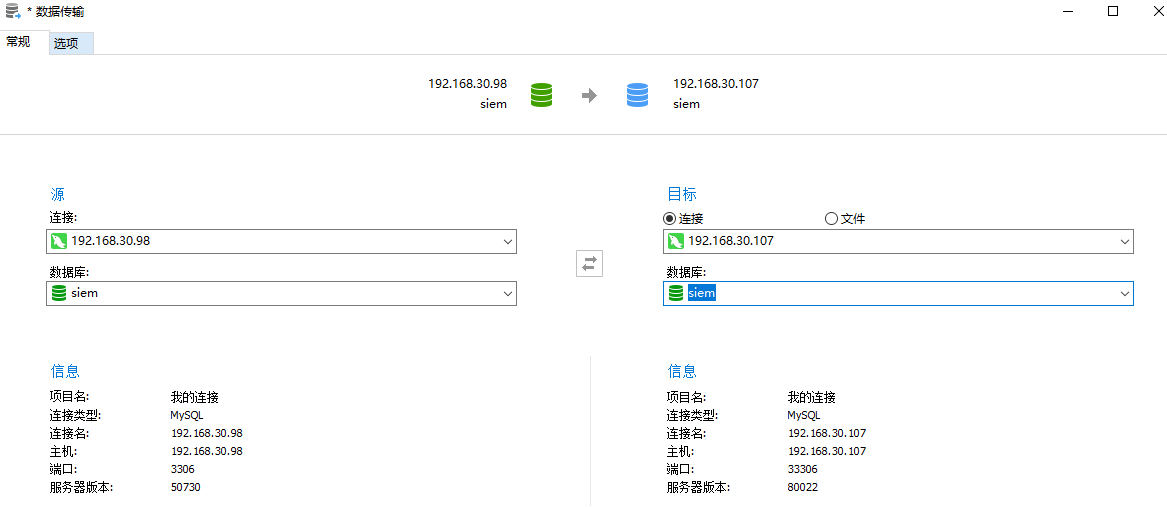
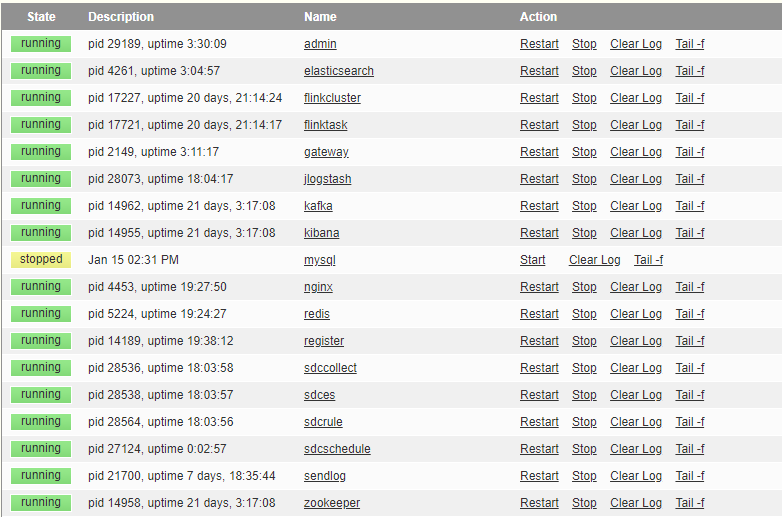
版本兼容问题1
mysql 8.0之后出的异常,MySQL 5.7.5及以上功能依赖检测功能,而使用的mysql是8.0版本.如果启用了ONLY_FULL_GROUP_BY SQL 模式(默认情况下)MySQL将拒绝选择列表,HAVING 条件或ORDER BY列表的查询引用在GROUP BY子句中既未命名的非集合列
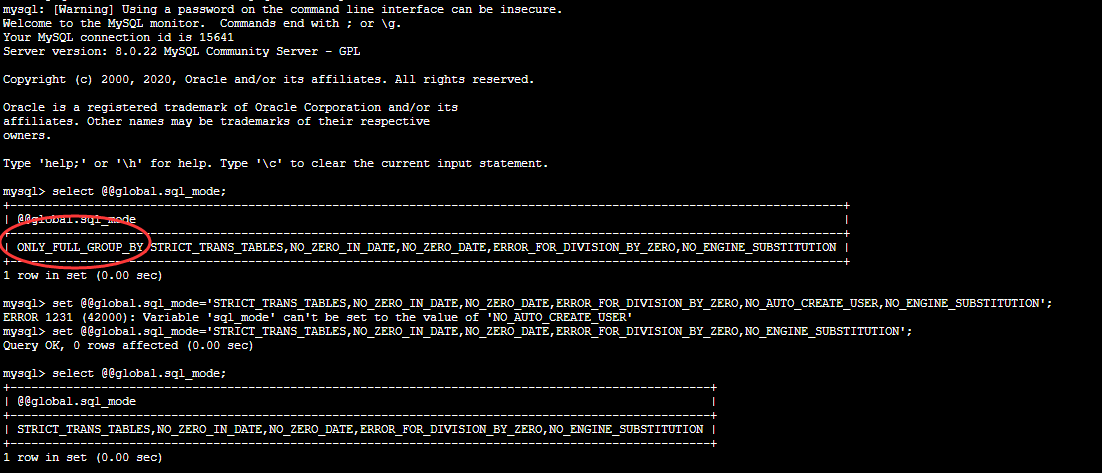
解决方法2
打开mysql配置文件:my.cnf
直接选择打开mysql配置文件,然后在最底部添加
sql_mode=STRICT_TRANS_TABLES,NO_ZERO_IN_DATE,NO_ZERO_DATE,ERROR_FOR_DIVISION_BY_ZERO,NO_AUTO_CREATE_USER,NO_ENGINE_SUBSTITUTION
重启mysql
创建只有查询权限的用户
mysql -uroot -pTransfar@123
create user 'chaxun'@'%' identified by 'Tranar@123';
grant select on *.* to 'chaxun'@'%' with grant option;
flush privileges;
ALTER USER 'chaxun'@'%' IDENTIFIED WITH mysql_native_password BY 'Trsfar@123';
Rancher搭建mysql主从集群
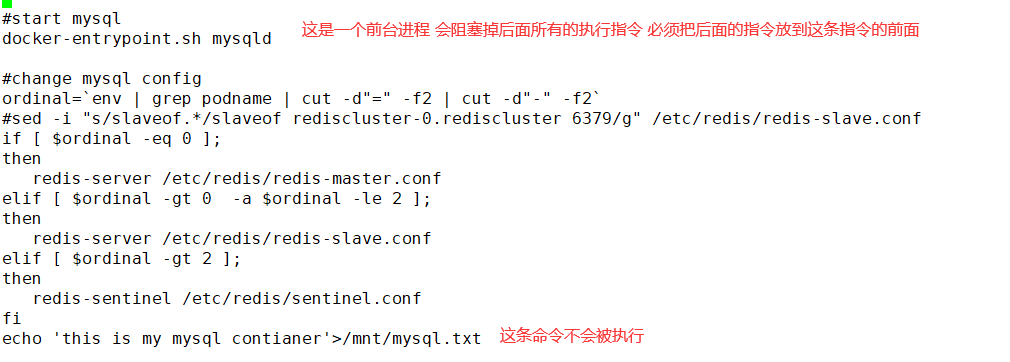
mysql数据存储
容器中的/var/lib/mysql 必须设置成有状态存储 这样即使容器重启 也不会使原来数据丢失

mysql容器启动的时候提示
ENTRYPOINT ["/bin/sh","/start-mysql.sh"]
/bin/sh start-mysql.sh 出现 let: not found
修改Dockerfile
ENTRYPOINT ["/bin/bash","/start-mysql.sh"]
主从集群搭建步骤
1.创建相关文件

2.文件内容

#!/bin/bash set -eo pipefail shopt -s nullglob # logging functions mysql_log() { local type="$1"; shift printf '%s [%s] [Entrypoint]: %s ' "$(date --rfc-3339=seconds)" "$type" "$*" } mysql_note() { mysql_log Note "$@" } mysql_warn() { mysql_log Warn "$@" >&2 } mysql_error() { mysql_log ERROR "$@" >&2 exit 1 } # usage: file_env VAR [DEFAULT] # ie: file_env 'XYZ_DB_PASSWORD' 'example' # (will allow for "$XYZ_DB_PASSWORD_FILE" to fill in the value of # "$XYZ_DB_PASSWORD" from a file, especially for Docker's secrets feature) file_env() { local var="$1" local fileVar="${var}_FILE" local def="${2:-}" if [ "${!var:-}" ] && [ "${!fileVar:-}" ]; then mysql_error "Both $var and $fileVar are set (but are exclusive)" fi local val="$def" if [ "${!var:-}" ]; then val="${!var}" elif [ "${!fileVar:-}" ]; then val="$(< "${!fileVar}")" fi export "$var"="$val" unset "$fileVar" } # check to see if this file is being run or sourced from another script _is_sourced() { # https://unix.stackexchange.com/a/215279 [ "${#FUNCNAME[@]}" -ge 2 ] && [ "${FUNCNAME[0]}" = '_is_sourced' ] && [ "${FUNCNAME[1]}" = 'source' ] } # usage: docker_process_init_files [file [file [...]]] # ie: docker_process_init_files /always-initdb.d/* # process initializer files, based on file extensions docker_process_init_files() { # mysql here for backwards compatibility "${mysql[@]}" mysql=( docker_process_sql ) echo local f for f; do case "$f" in *.sh) # https://github.com/docker-library/postgres/issues/450#issuecomment-393167936 # https://github.com/docker-library/postgres/pull/452 if [ -x "$f" ]; then mysql_note "$0: running $f" "$f" else mysql_note "$0: sourcing $f" . "$f" fi ;; *.sql) mysql_note "$0: running $f"; docker_process_sql < "$f"; echo ;; *.sql.gz) mysql_note "$0: running $f"; gunzip -c "$f" | docker_process_sql; echo ;; *.sql.xz) mysql_note "$0: running $f"; xzcat "$f" | docker_process_sql; echo ;; *) mysql_warn "$0: ignoring $f" ;; esac echo done } mysql_check_config() { local toRun=( "$@" --verbose --help ) errors if ! errors="$("${toRun[@]}" 2>&1 >/dev/null)"; then mysql_error $'mysqld failed while attempting to check config command was: '"${toRun[*]}"$' '"$errors" fi } # Fetch value from server config # We use mysqld --verbose --help instead of my_print_defaults because the # latter only show values present in config files, and not server defaults mysql_get_config() { local conf="$1"; shift "$@" --verbose --help --log-bin-index="$(mktemp -u)" 2>/dev/null | awk -v conf="$conf" '$1 == conf && /^[^ ]/ { sub(/^[^ ]+[ ]+/, ""); print; exit }' # match "datadir /some/path with/spaces in/it here" but not "--xyz=abc datadir (xyz)" } # Do a temporary startup of the MySQL server, for init purposes docker_temp_server_start() { if [ "${MYSQL_MAJOR}" = '5.6' ] || [ "${MYSQL_MAJOR}" = '5.7' ]; then "$@" --skip-networking --socket="${SOCKET}" & mysql_note "Waiting for server startup" local i for i in {30..0}; do # only use the root password if the database has already been initialized # so that it won't try to fill in a password file when it hasn't been set yet extraArgs=() if [ -z "$DATABASE_ALREADY_EXISTS" ]; then extraArgs+=( '--dont-use-mysql-root-password' ) fi if docker_process_sql "${extraArgs[@]}" --database=mysql <<<'SELECT 1' &> /dev/null; then break fi sleep 1 done if [ "$i" = 0 ]; then mysql_error "Unable to start server." fi else # For 5.7+ the server is ready for use as soon as startup command unblocks if ! "$@" --daemonize --skip-networking --socket="${SOCKET}"; then mysql_error "Unable to start server." fi fi } # Stop the server. When using a local socket file mysqladmin will block until # the shutdown is complete. docker_temp_server_stop() { if ! mysqladmin --defaults-extra-file=<( _mysql_passfile ) shutdown -uroot --socket="${SOCKET}"; then mysql_error "Unable to shut down server." fi } # Verify that the minimally required password settings are set for new databases. docker_verify_minimum_env() { if [ -z "$MYSQL_ROOT_PASSWORD" -a -z "$MYSQL_ALLOW_EMPTY_PASSWORD" -a -z "$MYSQL_RANDOM_ROOT_PASSWORD" ]; then mysql_error $'Database is uninitialized and password option is not specified You need to specify one of MYSQL_ROOT_PASSWORD, MYSQL_ALLOW_EMPTY_PASSWORD and MYSQL_RANDOM_ROOT_PASSWORD' fi } # creates folders for the database # also ensures permission for user mysql of run as root docker_create_db_directories() { local user; user="$(id -u)" # TODO other directories that are used by default? like /var/lib/mysql-files # see https://github.com/docker-library/mysql/issues/562 mkdir -p "$DATADIR" if [ "$user" = "0" ]; then # this will cause less disk access than `chown -R` find "$DATADIR" ! -user mysql -exec chown mysql '{}' + fi } # initializes the database directory docker_init_database_dir() { mysql_note "Initializing database files" if [ "$MYSQL_MAJOR" = '5.6' ]; then mysql_install_db --datadir="$DATADIR" --rpm --keep-my-cnf "${@:2}" else "$@" --initialize-insecure fi mysql_note "Database files initialized" if command -v mysql_ssl_rsa_setup > /dev/null && [ ! -e "$DATADIR/server-key.pem" ]; then # https://github.com/mysql/mysql-server/blob/23032807537d8dd8ee4ec1c4d40f0633cd4e12f9/packaging/deb-in/extra/mysql-systemd-start#L81-L84 mysql_note "Initializing certificates" mysql_ssl_rsa_setup --datadir="$DATADIR" mysql_note "Certificates initialized" fi } # Loads various settings that are used elsewhere in the script # This should be called after mysql_check_config, but before any other functions docker_setup_env() { # Get config declare -g DATADIR SOCKET DATADIR="$(mysql_get_config 'datadir' "$@")" SOCKET="$(mysql_get_config 'socket' "$@")" # Initialize values that might be stored in a file file_env 'MYSQL_ROOT_HOST' '%' file_env 'MYSQL_DATABASE' file_env 'MYSQL_USER' file_env 'MYSQL_PASSWORD' file_env 'MYSQL_ROOT_PASSWORD' declare -g DATABASE_ALREADY_EXISTS if [ -d "$DATADIR/mysql" ]; then DATABASE_ALREADY_EXISTS='true' fi } # Execute sql script, passed via stdin # usage: docker_process_sql [--dont-use-mysql-root-password] [mysql-cli-args] # ie: docker_process_sql --database=mydb <<<'INSERT ...' # ie: docker_process_sql --dont-use-mysql-root-password --database=mydb <my-file.sql docker_process_sql() { passfileArgs=() if [ '--dont-use-mysql-root-password' = "$1" ]; then passfileArgs+=( "$1" ) shift fi # args sent in can override this db, since they will be later in the command if [ -n "$MYSQL_DATABASE" ]; then set -- --database="$MYSQL_DATABASE" "$@" fi mysql --defaults-extra-file=<( _mysql_passfile "${passfileArgs[@]}") --protocol=socket -uroot -hlocalhost --socket="${SOCKET}" "$@" } # Initializes database with timezone info and root password, plus optional extra db/user docker_setup_db() { # Load timezone info into database if [ -z "$MYSQL_INITDB_SKIP_TZINFO" ]; then # sed is for https://bugs.mysql.com/bug.php?id=20545 mysql_tzinfo_to_sql /usr/share/zoneinfo | sed 's/Local time zone must be set--see zic manual page/FCTY/' | docker_process_sql --dont-use-mysql-root-password --database=mysql # tell docker_process_sql to not use MYSQL_ROOT_PASSWORD since it is not set yet fi # Generate random root password if [ -n "$MYSQL_RANDOM_ROOT_PASSWORD" ]; then export MYSQL_ROOT_PASSWORD="$(pwgen -1 32)" mysql_note "GENERATED ROOT PASSWORD: $MYSQL_ROOT_PASSWORD" fi # Sets root password and creates root users for non-localhost hosts local rootCreate= # default root to listen for connections from anywhere if [ -n "$MYSQL_ROOT_HOST" ] && [ "$MYSQL_ROOT_HOST" != 'localhost' ]; then # no, we don't care if read finds a terminating character in this heredoc # https://unix.stackexchange.com/questions/265149/why-is-set-o-errexit-breaking-this-read-heredoc-expression/265151#265151 read -r -d '' rootCreate <<-EOSQL || true CREATE USER 'root'@'${MYSQL_ROOT_HOST}' IDENTIFIED BY '${MYSQL_ROOT_PASSWORD}' ; GRANT ALL ON *.* TO 'root'@'${MYSQL_ROOT_HOST}' WITH GRANT OPTION ; EOSQL fi local passwordSet= if [ "$MYSQL_MAJOR" = '5.6' ]; then # no, we don't care if read finds a terminating character in this heredoc (see above) read -r -d '' passwordSet <<-EOSQL || true DELETE FROM mysql.user WHERE user NOT IN ('mysql.sys', 'mysqlxsys', 'root') OR host NOT IN ('localhost') ; SET PASSWORD FOR 'root'@'localhost'=PASSWORD('${MYSQL_ROOT_PASSWORD}') ; -- 5.5: https://github.com/mysql/mysql-server/blob/e48d775c6f066add457fa8cfb2ebc4d5ff0c7613/scripts/mysql_secure_installation.sh#L192-L210 -- 5.6: https://github.com/mysql/mysql-server/blob/06bc670db0c0e45b3ea11409382a5c315961f682/scripts/mysql_secure_installation.sh#L218-L236 -- 5.7: https://github.com/mysql/mysql-server/blob/913071c0b16cc03e703308250d795bc381627e37/client/mysql_secure_installation.cc#L792-L818 -- 8.0: https://github.com/mysql/mysql-server/blob/b93c1661d689c8b7decc7563ba15f6ed140a4eb6/client/mysql_secure_installation.cc#L726-L749 DELETE FROM mysql.db WHERE Db='test' OR Db='test\_%' ; -- https://github.com/docker-library/mysql/pull/479#issuecomment-414561272 ("This is only needed for 5.5 and 5.6") EOSQL else # no, we don't care if read finds a terminating character in this heredoc (see above) read -r -d '' passwordSet <<-EOSQL || true ALTER USER 'root'@'localhost' IDENTIFIED BY '${MYSQL_ROOT_PASSWORD}' ; EOSQL fi # tell docker_process_sql to not use MYSQL_ROOT_PASSWORD since it is just now being set docker_process_sql --dont-use-mysql-root-password --database=mysql <<-EOSQL -- What's done in this file shouldn't be replicated -- or products like mysql-fabric won't work SET @@SESSION.SQL_LOG_BIN=0; ${passwordSet} GRANT ALL ON *.* TO 'root'@'localhost' WITH GRANT OPTION ; FLUSH PRIVILEGES ; ${rootCreate} DROP DATABASE IF EXISTS test ; EOSQL # Creates a custom database and user if specified if [ -n "$MYSQL_DATABASE" ]; then mysql_note "Creating database ${MYSQL_DATABASE}" docker_process_sql --database=mysql <<<"CREATE DATABASE IF NOT EXISTS \`$MYSQL_DATABASE\` ;" fi if [ -n "$MYSQL_USER" ] && [ -n "$MYSQL_PASSWORD" ]; then mysql_note "Creating user ${MYSQL_USER}" docker_process_sql --database=mysql <<<"CREATE USER '$MYSQL_USER'@'%' IDENTIFIED BY '$MYSQL_PASSWORD' ;" if [ -n "$MYSQL_DATABASE" ]; then mysql_note "Giving user ${MYSQL_USER} access to schema ${MYSQL_DATABASE}" docker_process_sql --database=mysql <<<"GRANT ALL ON \`${MYSQL_DATABASE//_/\_}\`.* TO '$MYSQL_USER'@'%' ;" fi fi } _mysql_passfile() { # echo the password to the "file" the client uses # the client command will use process substitution to create a file on the fly # ie: --defaults-extra-file=<( _mysql_passfile ) if [ '--dont-use-mysql-root-password' != "$1" ] && [ -n "$MYSQL_ROOT_PASSWORD" ]; then cat <<-EOF [client] password="${MYSQL_ROOT_PASSWORD}" EOF fi } # Mark root user as expired so the password must be changed before anything # else can be done (only supported for 5.6+) mysql_expire_root_user() { if [ -n "$MYSQL_ONETIME_PASSWORD" ]; then docker_process_sql --database=mysql <<-EOSQL ALTER USER 'root'@'%' PASSWORD EXPIRE; EOSQL fi } mysql_create_cluster() { mysql_note "Created mysql cluster......" ordinal=`env | grep podname | cut -d"=" -f2 | cut -d"-" -f2` if [ $ordinal -eq 0 ]; then mysql_note "Created Slave User on master node......" docker_process_sql --database=mysql <<<"CREATE USER 'repl'@'%' IDENTIFIED BY 'repl456789';GRANT REPLICATION SLAVE ON *.* to 'repl'@'%' IDENTIFIED BY 'repl456789';FLUSH PRIVILEGES;" else mysql_note "Created Master link info on slave node" docker_process_sql --database=mysql <<<"change master to master_host='mysqlcluster-0.mysqlcluster',master_user='repl',master_password='repl456789';FLUSH PRIVILEGES;" fi } # check arguments for an option that would cause mysqld to stop # return true if there is one _mysql_want_help() { local arg for arg; do case "$arg" in -'?'|--help|--print-defaults|-V|--version) return 0 ;; esac done return 1 } _main() { # if command starts with an option, prepend mysqld if [ "${1:0:1}" = '-' ]; then set -- mysqld "$@" fi # skip setup if they aren't running mysqld or want an option that stops mysqld if [ "$1" = 'mysqld' ] && ! _mysql_want_help "$@"; then mysql_note "Entrypoint script for MySQL Server ${MYSQL_VERSION} started." mysql_check_config "$@" # Load various environment variables docker_setup_env "$@" docker_create_db_directories # If container is started as root user, restart as dedicated mysql user if [ "$(id -u)" = "0" ]; then mysql_note "Switching to dedicated user 'mysql'" exec gosu mysql "$BASH_SOURCE" "$@" fi # there's no database, so it needs to be initialized if [ -z "$DATABASE_ALREADY_EXISTS" ]; then docker_verify_minimum_env # check dir permissions to reduce likelihood of half-initialized database ls /docker-entrypoint-initdb.d/ > /dev/null docker_init_database_dir "$@" mysql_note "Starting temporary server" docker_temp_server_start "$@" mysql_note "Temporary server started." docker_setup_db docker_process_init_files /docker-entrypoint-initdb.d/* mysql_create_cluster mysql_expire_root_user mysql_note "Stopping temporary server" docker_temp_server_stop mysql_note "Temporary server stopped" echo mysql_note "MySQL init process done. Ready for start up." echo fi fi exec "$@" } # If we are sourced from elsewhere, don't perform any further actions if ! _is_sourced; then _main "$@" fi

CURDIR=$(cd $(dirname ${BASH_SOURCE[0]}); pwd )
cd $CURDIR
sudo docker build -t 192.168.30.13/aaa/mysql .
sudo docker push 192.168.30.13/aaaa/mysql

FROM 192.168.30.13/library/mysql:5.7.32 MAINTAINER aaaabbbb ENV TZ=Asia/Shanghai RUN ln -snf /usr/share/zoneinfo/$TZ /etc/localtime && echo '$TZ' > /etc/timezone COPY master.cnf /etc/mysql/conf.d/master.cnf COPY slave.cnf /etc/mysql/conf.d/slave.cnf COPY start-mysql.sh /start-mysql.sh COPY docker-entrypoint.sh /usr/local/bin/ RUN chmod 755 /usr/local/bin/docker-entrypoint.sh ENTRYPOINT ["/bin/bash","/start-mysql.sh"]

[mysqld] server-id=1 log-bin=mysql-bin slave.cnf [mysqld] server-id=2 log-bin=mysql-bin

#! /usr/bin/env bash #change mysql config ordinal=`env | grep podname | cut -d"=" -f2 | cut -d"-" -f2` let serverid=$ordinal+1 sed -i "s/server-id=.*/server-id=$serverid/g" /etc/mysql/conf.d/slave.cnf sed -i "s/server-id=.*/server-id=$serverid/g" /etc/mysql/conf.d/master.cnf if [ $ordinal -eq 0 ]; then rm -fr /etc/mysql/conf.d/slave.cnf else rm -fr /etc/mysql/conf.d/master.cnf fi #start mysql docker-entrypoint.sh mysqld

#!/bin/bash set -eo pipefail shopt -s nullglob # logging functions mysql_log() { local type="$1"; shift printf '%s [%s] [Entrypoint]: %s ' "$(date --rfc-3339=seconds)" "$type" "$*" } mysql_note() { mysql_log Note "$@" } mysql_warn() { mysql_log Warn "$@" >&2 } mysql_error() { mysql_log ERROR "$@" >&2 exit 1 } # usage: file_env VAR [DEFAULT] # ie: file_env 'XYZ_DB_PASSWORD' 'example' # (will allow for "$XYZ_DB_PASSWORD_FILE" to fill in the value of # "$XYZ_DB_PASSWORD" from a file, especially for Docker's secrets feature) file_env() { local var="$1" local fileVar="${var}_FILE" local def="${2:-}" if [ "${!var:-}" ] && [ "${!fileVar:-}" ]; then mysql_error "Both $var and $fileVar are set (but are exclusive)" fi local val="$def" if [ "${!var:-}" ]; then val="${!var}" elif [ "${!fileVar:-}" ]; then val="$(< "${!fileVar}")" fi export "$var"="$val" unset "$fileVar" } # check to see if this file is being run or sourced from another script _is_sourced() { # https://unix.stackexchange.com/a/215279 [ "${#FUNCNAME[@]}" -ge 2 ] && [ "${FUNCNAME[0]}" = '_is_sourced' ] && [ "${FUNCNAME[1]}" = 'source' ] } # usage: docker_process_init_files [file [file [...]]] # ie: docker_process_init_files /always-initdb.d/* # process initializer files, based on file extensions docker_process_init_files() { # mysql here for backwards compatibility "${mysql[@]}" mysql=( docker_process_sql ) echo local f for f; do case "$f" in *.sh) # https://github.com/docker-library/postgres/issues/450#issuecomment-393167936 # https://github.com/docker-library/postgres/pull/452 if [ -x "$f" ]; then mysql_note "$0: running $f" "$f" else mysql_note "$0: sourcing $f" . "$f" fi ;; *.sql) mysql_note "$0: running $f"; docker_process_sql < "$f"; echo ;; *.sql.gz) mysql_note "$0: running $f"; gunzip -c "$f" | docker_process_sql; echo ;; *.sql.xz) mysql_note "$0: running $f"; xzcat "$f" | docker_process_sql; echo ;; *) mysql_warn "$0: ignoring $f" ;; esac echo done } mysql_check_config() { local toRun=( "$@" --verbose --help ) errors if ! errors="$("${toRun[@]}" 2>&1 >/dev/null)"; then mysql_error $'mysqld failed while attempting to check config command was: '"${toRun[*]}"$' '"$errors" fi } # Fetch value from server config # We use mysqld --verbose --help instead of my_print_defaults because the # latter only show values present in config files, and not server defaults mysql_get_config() { local conf="$1"; shift "$@" --verbose --help --log-bin-index="$(mktemp -u)" 2>/dev/null | awk -v conf="$conf" '$1 == conf && /^[^ ]/ { sub(/^[^ ]+[ ]+/, ""); print; exit }' # match "datadir /some/path with/spaces in/it here" but not "--xyz=abc datadir (xyz)" } # Do a temporary startup of the MySQL server, for init purposes docker_temp_server_start() { if [ "${MYSQL_MAJOR}" = '5.6' ] || [ "${MYSQL_MAJOR}" = '5.7' ]; then "$@" --skip-networking --socket="${SOCKET}" & mysql_note "Waiting for server startup" local i for i in {30..0}; do # only use the root password if the database has already been initialized # so that it won't try to fill in a password file when it hasn't been set yet extraArgs=() if [ -z "$DATABASE_ALREADY_EXISTS" ]; then extraArgs+=( '--dont-use-mysql-root-password' ) fi if docker_process_sql "${extraArgs[@]}" --database=mysql <<<'SELECT 1' &> /dev/null; then break fi sleep 1 done if [ "$i" = 0 ]; then mysql_error "Unable to start server." fi else # For 5.7+ the server is ready for use as soon as startup command unblocks if ! "$@" --daemonize --skip-networking --socket="${SOCKET}"; then mysql_error "Unable to start server." fi fi } # Stop the server. When using a local socket file mysqladmin will block until # the shutdown is complete. docker_temp_server_stop() { if ! mysqladmin --defaults-extra-file=<( _mysql_passfile ) shutdown -uroot --socket="${SOCKET}"; then mysql_error "Unable to shut down server." fi } # Verify that the minimally required password settings are set for new databases. docker_verify_minimum_env() { if [ -z "$MYSQL_ROOT_PASSWORD" -a -z "$MYSQL_ALLOW_EMPTY_PASSWORD" -a -z "$MYSQL_RANDOM_ROOT_PASSWORD" ]; then mysql_error $'Database is uninitialized and password option is not specified You need to specify one of MYSQL_ROOT_PASSWORD, MYSQL_ALLOW_EMPTY_PASSWORD and MYSQL_RANDOM_ROOT_PASSWORD' fi } # creates folders for the database # also ensures permission for user mysql of run as root docker_create_db_directories() { local user; user="$(id -u)" # TODO other directories that are used by default? like /var/lib/mysql-files # see https://github.com/docker-library/mysql/issues/562 mkdir -p "$DATADIR" if [ "$user" = "0" ]; then # this will cause less disk access than `chown -R` find "$DATADIR" ! -user mysql -exec chown mysql '{}' + fi } # initializes the database directory docker_init_database_dir() { mysql_note "Initializing database files" if [ "$MYSQL_MAJOR" = '5.6' ]; then mysql_install_db --datadir="$DATADIR" --rpm --keep-my-cnf "${@:2}" else "$@" --initialize-insecure fi mysql_note "Database files initialized" if command -v mysql_ssl_rsa_setup > /dev/null && [ ! -e "$DATADIR/server-key.pem" ]; then # https://github.com/mysql/mysql-server/blob/23032807537d8dd8ee4ec1c4d40f0633cd4e12f9/packaging/deb-in/extra/mysql-systemd-start#L81-L84 mysql_note "Initializing certificates" mysql_ssl_rsa_setup --datadir="$DATADIR" mysql_note "Certificates initialized" fi } # Loads various settings that are used elsewhere in the script # This should be called after mysql_check_config, but before any other functions docker_setup_env() { # Get config declare -g DATADIR SOCKET DATADIR="$(mysql_get_config 'datadir' "$@")" SOCKET="$(mysql_get_config 'socket' "$@")" # Initialize values that might be stored in a file file_env 'MYSQL_ROOT_HOST' '%' file_env 'MYSQL_DATABASE' file_env 'MYSQL_USER' file_env 'MYSQL_PASSWORD' file_env 'MYSQL_ROOT_PASSWORD' declare -g DATABASE_ALREADY_EXISTS if [ -d "$DATADIR/mysql" ]; then DATABASE_ALREADY_EXISTS='true' fi } # Execute sql script, passed via stdin # usage: docker_process_sql [--dont-use-mysql-root-password] [mysql-cli-args] # ie: docker_process_sql --database=mydb <<<'INSERT ...' # ie: docker_process_sql --dont-use-mysql-root-password --database=mydb <my-file.sql docker_process_sql() { passfileArgs=() if [ '--dont-use-mysql-root-password' = "$1" ]; then passfileArgs+=( "$1" ) shift fi # args sent in can override this db, since they will be later in the command if [ -n "$MYSQL_DATABASE" ]; then set -- --database="$MYSQL_DATABASE" "$@" fi mysql --defaults-extra-file=<( _mysql_passfile "${passfileArgs[@]}") --protocol=socket -uroot -hlocalhost --socket="${SOCKET}" "$@" } # Initializes database with timezone info and root password, plus optional extra db/user docker_setup_db() { # Load timezone info into database if [ -z "$MYSQL_INITDB_SKIP_TZINFO" ]; then # sed is for https://bugs.mysql.com/bug.php?id=20545 mysql_tzinfo_to_sql /usr/share/zoneinfo | sed 's/Local time zone must be set--see zic manual page/FCTY/' | docker_process_sql --dont-use-mysql-root-password --database=mysql # tell docker_process_sql to not use MYSQL_ROOT_PASSWORD since it is not set yet fi # Generate random root password if [ -n "$MYSQL_RANDOM_ROOT_PASSWORD" ]; then export MYSQL_ROOT_PASSWORD="$(pwgen -1 32)" mysql_note "GENERATED ROOT PASSWORD: $MYSQL_ROOT_PASSWORD" fi # Sets root password and creates root users for non-localhost hosts local rootCreate= # default root to listen for connections from anywhere if [ -n "$MYSQL_ROOT_HOST" ] && [ "$MYSQL_ROOT_HOST" != 'localhost' ]; then # no, we don't care if read finds a terminating character in this heredoc # https://unix.stackexchange.com/questions/265149/why-is-set-o-errexit-breaking-this-read-heredoc-expression/265151#265151 read -r -d '' rootCreate <<-EOSQL || true CREATE USER 'root'@'${MYSQL_ROOT_HOST}' IDENTIFIED BY '${MYSQL_ROOT_PASSWORD}' ; GRANT ALL ON *.* TO 'root'@'${MYSQL_ROOT_HOST}' WITH GRANT OPTION ; EOSQL fi local passwordSet= if [ "$MYSQL_MAJOR" = '5.6' ]; then # no, we don't care if read finds a terminating character in this heredoc (see above) read -r -d '' passwordSet <<-EOSQL || true DELETE FROM mysql.user WHERE user NOT IN ('mysql.sys', 'mysqlxsys', 'root') OR host NOT IN ('localhost') ; SET PASSWORD FOR 'root'@'localhost'=PASSWORD('${MYSQL_ROOT_PASSWORD}') ; -- 5.5: https://github.com/mysql/mysql-server/blob/e48d775c6f066add457fa8cfb2ebc4d5ff0c7613/scripts/mysql_secure_installation.sh#L192-L210 -- 5.6: https://github.com/mysql/mysql-server/blob/06bc670db0c0e45b3ea11409382a5c315961f682/scripts/mysql_secure_installation.sh#L218-L236 -- 5.7: https://github.com/mysql/mysql-server/blob/913071c0b16cc03e703308250d795bc381627e37/client/mysql_secure_installation.cc#L792-L818 -- 8.0: https://github.com/mysql/mysql-server/blob/b93c1661d689c8b7decc7563ba15f6ed140a4eb6/client/mysql_secure_installation.cc#L726-L749 DELETE FROM mysql.db WHERE Db='test' OR Db='test\_%' ; -- https://github.com/docker-library/mysql/pull/479#issuecomment-414561272 ("This is only needed for 5.5 and 5.6") EOSQL else # no, we don't care if read finds a terminating character in this heredoc (see above) read -r -d '' passwordSet <<-EOSQL || true ALTER USER 'root'@'localhost' IDENTIFIED BY '${MYSQL_ROOT_PASSWORD}' ; EOSQL fi # tell docker_process_sql to not use MYSQL_ROOT_PASSWORD since it is just now being set docker_process_sql --dont-use-mysql-root-password --database=mysql <<-EOSQL -- What's done in this file shouldn't be replicated -- or products like mysql-fabric won't work SET @@SESSION.SQL_LOG_BIN=0; ${passwordSet} GRANT ALL ON *.* TO 'root'@'localhost' WITH GRANT OPTION ; FLUSH PRIVILEGES ; ${rootCreate} DROP DATABASE IF EXISTS test ; EOSQL # Creates a custom database and user if specified if [ -n "$MYSQL_DATABASE" ]; then mysql_note "Creating database ${MYSQL_DATABASE}" docker_process_sql --database=mysql <<<"CREATE DATABASE IF NOT EXISTS \`$MYSQL_DATABASE\` ;" fi if [ -n "$MYSQL_USER" ] && [ -n "$MYSQL_PASSWORD" ]; then mysql_note "Creating user ${MYSQL_USER}" docker_process_sql --database=mysql <<<"CREATE USER '$MYSQL_USER'@'%' IDENTIFIED BY '$MYSQL_PASSWORD' ;" if [ -n "$MYSQL_DATABASE" ]; then mysql_note "Giving user ${MYSQL_USER} access to schema ${MYSQL_DATABASE}" docker_process_sql --database=mysql <<<"GRANT ALL ON \`${MYSQL_DATABASE//_/\_}\`.* TO '$MYSQL_USER'@'%' ;" fi fi } _mysql_passfile() { # echo the password to the "file" the client uses # the client command will use process substitution to create a file on the fly # ie: --defaults-extra-file=<( _mysql_passfile ) if [ '--dont-use-mysql-root-password' != "$1" ] && [ -n "$MYSQL_ROOT_PASSWORD" ]; then cat <<-EOF [client] password="${MYSQL_ROOT_PASSWORD}" EOF fi } # Mark root user as expired so the password must be changed before anything # else can be done (only supported for 5.6+) mysql_expire_root_user() { if [ -n "$MYSQL_ONETIME_PASSWORD" ]; then docker_process_sql --database=mysql <<-EOSQL ALTER USER 'root'@'%' PASSWORD EXPIRE; EOSQL fi } mysql_create_cluster() { mysql_note "Created mysql cluster......" ordinal=`env | grep podname | cut -d"=" -f2 | cut -d"-" -f2` if [ $ordinal -eq 0 ]; then mysql_note "Created Slave User on master node......" docker_process_sql --database=mysql <<<"CREATE USER 'repl'@'%' IDENTIFIED BY 'repl456789';GRANT REPLICATION SLAVE ON *.* to 'repl'@'%';ALTER USER 'repl'@'%' IDENTIFIED WITH caching_sha2_password BY 'repl456789';FLUSH PRIVILEGES;" else mysql_note "Created Master link info on slave node" docker_process_sql --database=mysql <<<"change master to master_host='mysqlcluster-0.mysqlcluster',master_user='repl',master_password='repl456789',get_master_public_key=1;FLUSH PRIVILEGES;" fi } # check arguments for an option that would cause mysqld to stop # return true if there is one _mysql_want_help() { local arg for arg; do case "$arg" in -'?'|--help|--print-defaults|-V|--version) return 0 ;; esac done return 1 } _main() { # if command starts with an option, prepend mysqld if [ "${1:0:1}" = '-' ]; then set -- mysqld "$@" fi # skip setup if they aren't running mysqld or want an option that stops mysqld if [ "$1" = 'mysqld' ] && ! _mysql_want_help "$@"; then mysql_note "Entrypoint script for MySQL Server ${MYSQL_VERSION} started." mysql_check_config "$@" # Load various environment variables docker_setup_env "$@" docker_create_db_directories # If container is started as root user, restart as dedicated mysql user if [ "$(id -u)" = "0" ]; then mysql_note "Switching to dedicated user 'mysql'" exec gosu mysql "$BASH_SOURCE" "$@" fi # there's no database, so it needs to be initialized if [ -z "$DATABASE_ALREADY_EXISTS" ]; then docker_verify_minimum_env # check dir permissions to reduce likelihood of half-initialized database ls /docker-entrypoint-initdb.d/ > /dev/null docker_init_database_dir "$@" mysql_note "Starting temporary server" docker_temp_server_start "$@" mysql_note "Temporary server started." docker_setup_db docker_process_init_files /docker-entrypoint-initdb.d/* mysql_create_cluster mysql_expire_root_user mysql_note "Stopping temporary server" docker_temp_server_stop mysql_note "Temporary server stopped" echo mysql_note "MySQL init process done. Ready for start up." echo fi fi exec "$@" } # If we are sourced from elsewhere, don't perform any further actions if ! _is_sourced; then _main "$@" fi
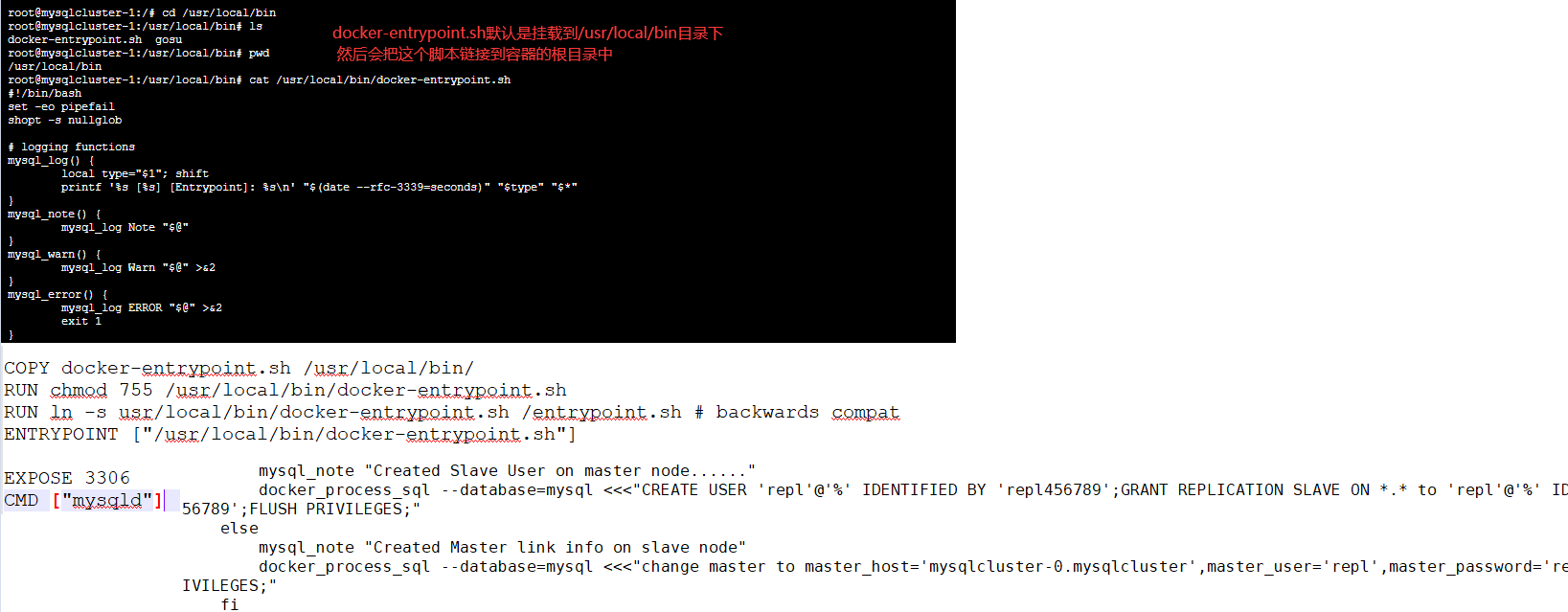
3.上面脚本的执行成功的条件一定要先给pod设置一个podname的环境变量 否则start-mysql.sh脚本会执行失败.
主从复制最终效果
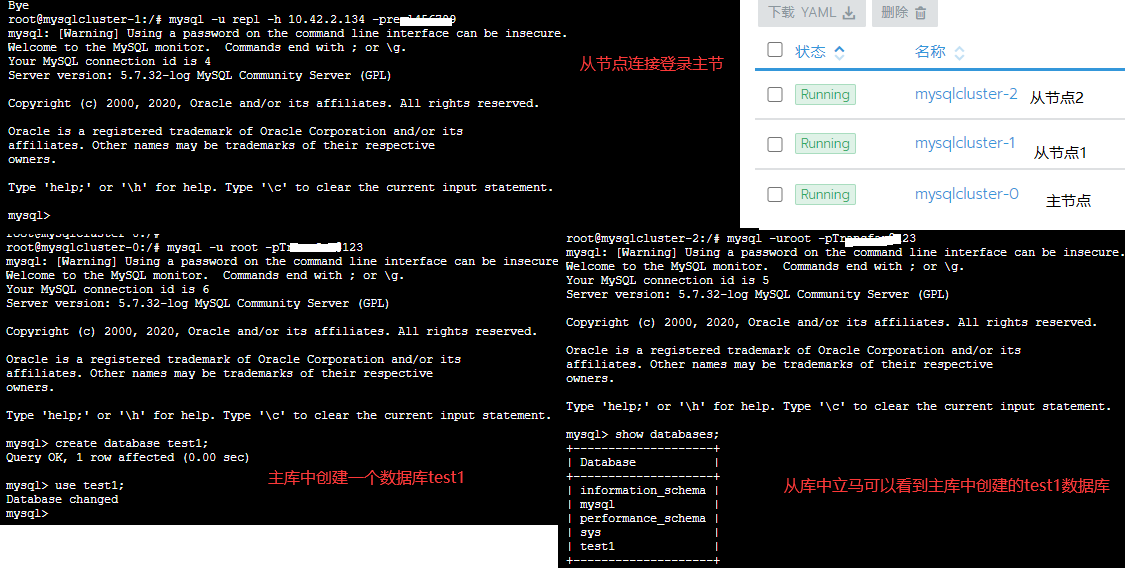
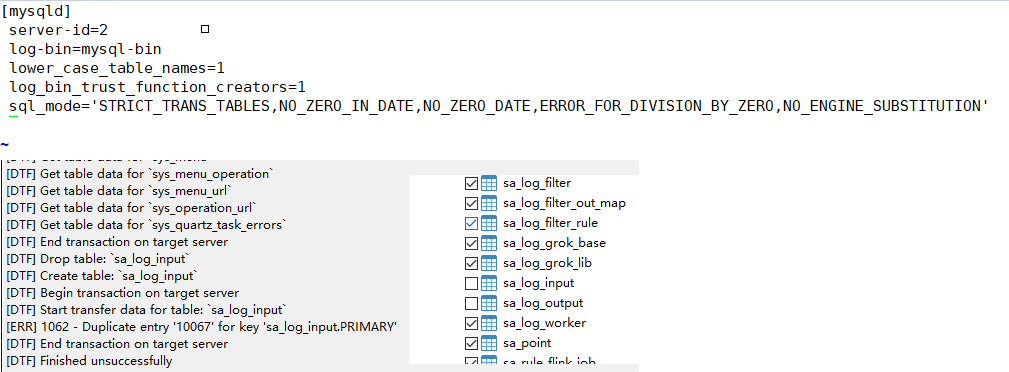

数据库启动初始化数据

docker_process_sql --database=mysql <<<"CREATE DATABASE IF NOT EXISTS siem DEFAULT CHARACTER SET utf8;" # init siem db of data mysql_note "Starting data to siem.........." docker_process_sql --database=siem </siem.sql mysql_note "Stop siem db..........."

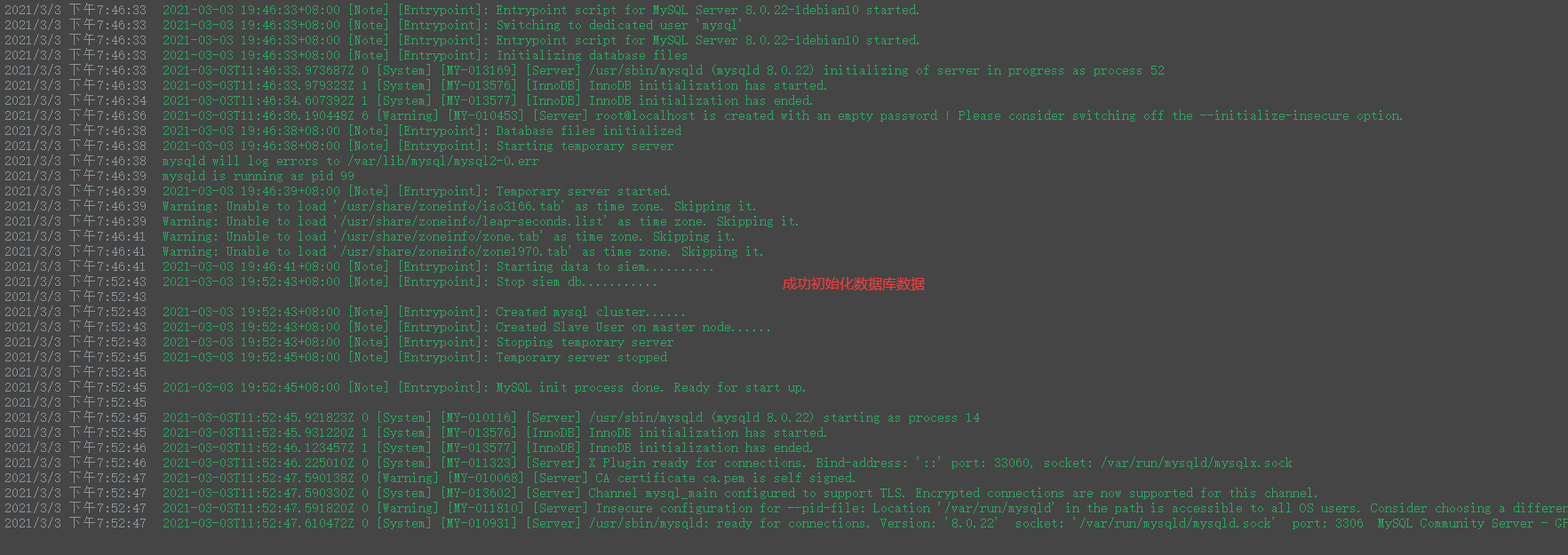
初始化数据删除无用数据
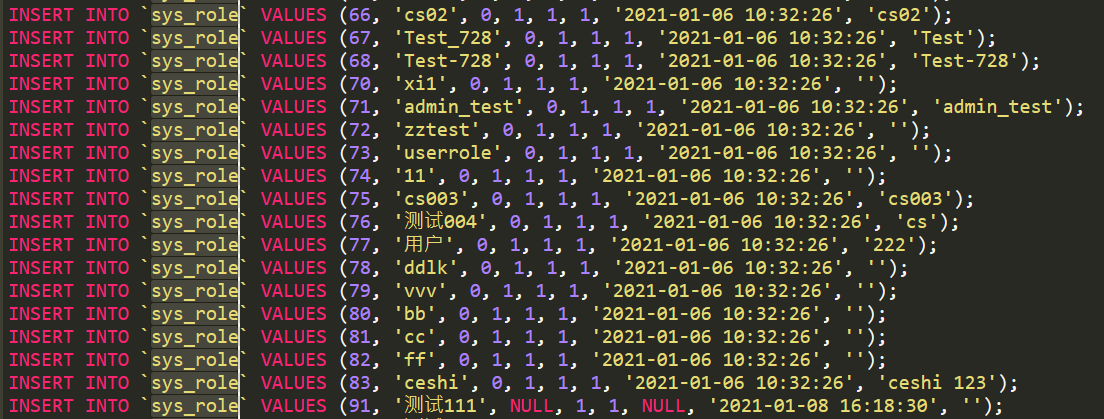
sublime删除选中的多行文本:
1. 选中关键词/句 注意选取具有唯一性的标识
2. Alt+F3全选 选中所有的该词/句(这里不会区分大小写)
3. 依次选择编辑–行--删除行 快捷键:Ctrl+Shift+K
mysql容器中添加自定义配置文件
直接添加是不会生效的 需要修改配置的文件的属主和权限
chown mysql:mysql /etc/mysql/conf.d/master.cnf
chown mysql:mysql /etc/mysql/conf.d/slave.cnf
chmod 644 /etc/mysql/conf.d/master.cnf
chmod 644 /etc/mysql/conf.d/slave.cnf
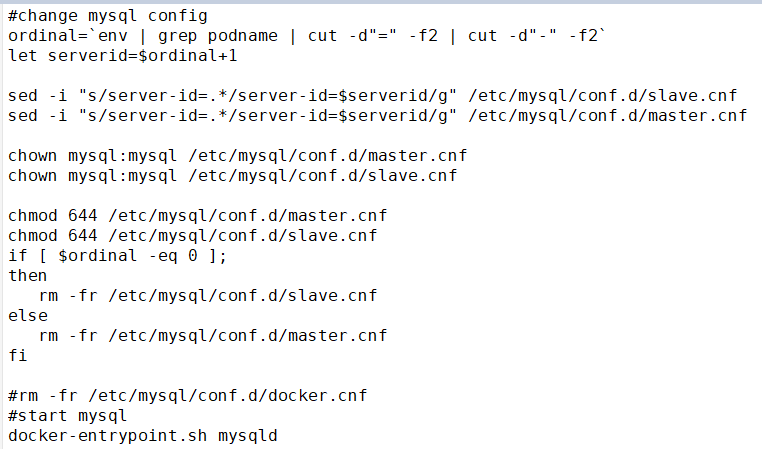

不修改文件权限mysql会直接忽略对应的配置文件,所以master.cnf中对应的配置就不会生效
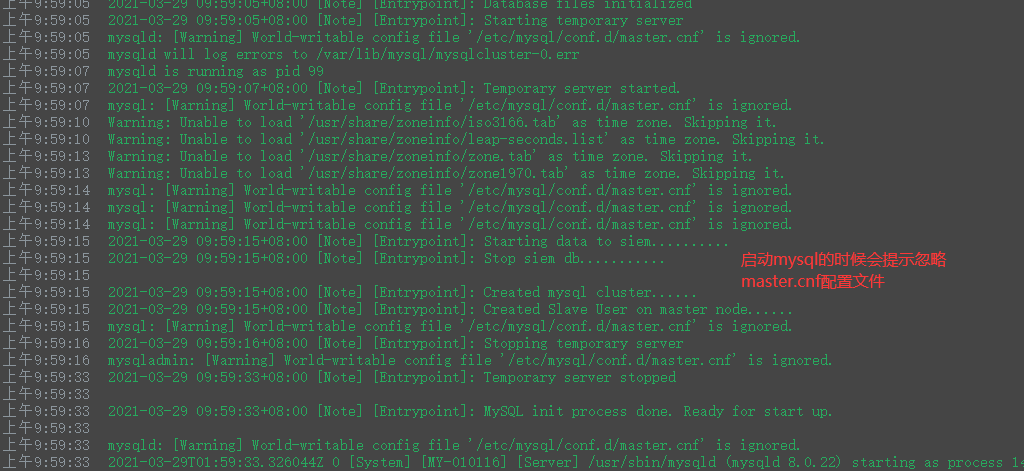
source初始数据缓慢
用navicat导出来的数据结构后然后在myql中使用source的话会非常的缓慢
速度慢原因:200多万条数据,就 insert into 了200多万次


用mysqldump工具导出,唯一区别是insert into方式不一样.一次insert可以同时插入多条记录
mysqldump -uroot -p Transfar siem -e --max_allowed_packet=1048576 --net_buffer_length=16384 >siem2.sql


mysql使用普通用户启动调试
